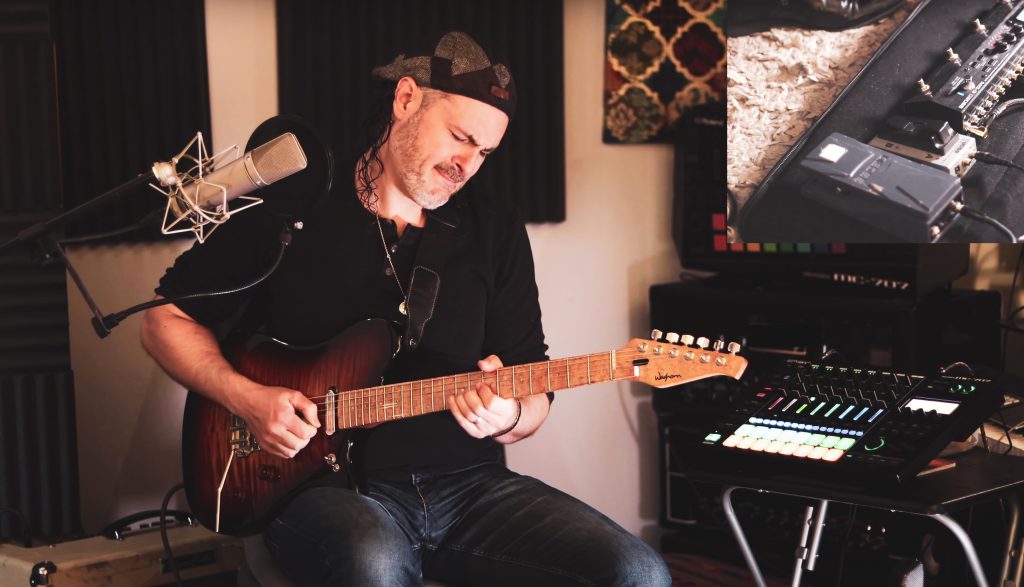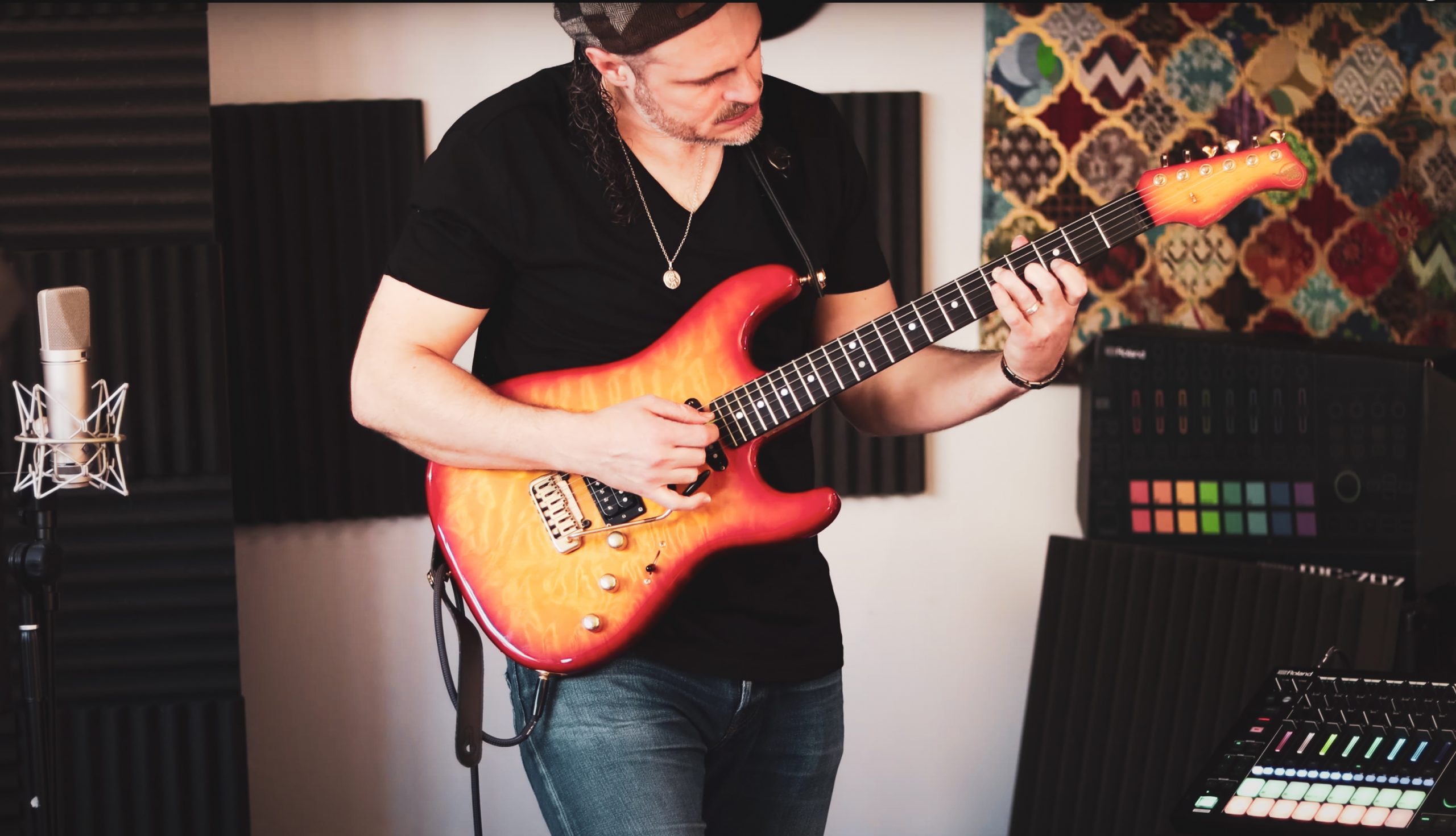From fusion and jazz originals to playing with prog legend Steven Wilson, Alex Hutchings is constantly pushing the limits of his instrument. A whiz with technology, it should come as no surprise that he’s embraced guitar synths and MIDI throughout his career. Still, even for a non-traditional player, his recent videos featuring the MC-707 GROOVEBOX and the BOSS MS-3 are making serious waves. Utilizing the Scene Chain function with guitar sound design and bank triggering, Hutchings is writing a new playbook. He speaks about his multi-genre influences, walks us through his setup, and reveals why MIDI guitar is about more than just sounds.
Multi-Genre Experimentation
Your work with the MC-707 and MS-3 is innovative. One of your viewers described it as a combination of Jamiroquai, Tom Morello, and Flat Eric. As a guitarist, what drives you to cross-pollinate drum and bass with hip-hop?
I’m good friends with a chap named David Ahlund. He’s into the dance production side of music and is an expert on the GROOVEBOX series. I’m influenced by listening to his work. My friend Dan at Roland wanted to see what I would do with the MC-707, which combines recording, sequencing, synths, and effects with a deep library of loops and sounds. I think they expected me to play with the acoustic drum kits and from more of a fusion kind of standpoint. When I received the MC 707, I gravitated to the dance kits and the synth sounds because I also love that kind of music.
Advanced Scene Chaining
The way you move through Scenes with the MC-707 is dazzling. Walk us through your setup and how you get the MS-3 and the MC-707 to talk to each other so seamlessly.
I decided to use the BOSS MS-3 footswitch, which is something I’ve been playing around with for a few years. A lot of people know I’ve worked with BOSS for many years. I thought it’d be fun to connect the MS-3 via MIDI and experiment with controlling the MC-707 from the device. The MS-3 plugs into my amp here, and then I’ve got a MIDI cable out of there into the MC-707.
There’s a function called Scene Chain which lets me tell the MC-707 to go through the different Scenes I’ve created in the order I choose. For example, scene one is a drumbeat. The next scene has a cool little bassline. Here, I mix it up with this little “Get Ur Freak On”- style groove. If I let that scene chain run, I can change guitar patches on the MS-3 freely and play along to the MC as if it’s a normal backing track player.
"When I received the MC 707, I gravitated to the dance kits and the synth sounds because I also love that kind of music."
Process Details
So, how did you move through the scenes in real-time?
Where it gets really cool for me is that I can move through an arrangement in real-time by triggering scenes on the MC-707 with the MS-3. So with the MS-3, when I change my guitar patch, I can also have it send out a little MIDI message called a Program Change. This will tell the MC-707 to start playing whatever Scene I want. I can play guitar patch three, and the Program Change message is saved inside the patch. By turning the Scene Chain function off, I can select a Scene and just keep a groove going if I want to. It won’t automatically roll into the next Scene until I tell it to.
What are some of the benefits of these setups?
One thing that came to mind was, if you’re playing with a live drummer, they could monitor the MC-707 like a click track. You could then also send those grooves to the PA. Plus, all your time-based guitar effects would always be in time.

Transportive Tones
How did you create that opening atmospheric, ambient guitar patch or the sounds in the hip-hop section?
All the guitar effects are from the MS-3. BOSS products can have multiple assigns, which means multiple things happening at once. On the atmospheric patch, I’ve got three or four delays or something. I love the patch I created and wanted the track to start with that.
The hip-hop section, and all the backing tracks, I created with the internal sounds. It’s quite intuitive to play them in because the pads are set up like a keyboard. That one is a woodwind instrument I morphed with effects. It sounds like a piano but up an octave.
"Music is always moving forward and developing. We all love old '60s and '70s albums, but I've not been afraid to look at the future as well."
Expanding Sounds
The MC-707 and its little sibling the MC-101 both have the ZEN-Core library and capabilities like Scene Chain. How can these tools help a player looking to explore new sounds and approaches?
The GROOVEBOX series is really cool if you’re into electronic sounds and that kind of stuff. Music is always moving forward and developing. We all love old ’60s and ’70s albums and all that stuff, but I’ve not been afraid to look at the future as well. It’s cool to meld it all together, and this is a great way of getting modern sounds in your music.
One thing I’ve been thinking about putting up is a video where I’m using guitar from my SY-1000 to trigger the sounds. It’s something I’ve been experimenting with. I haven’t written a track just yet, but that might be my next plan.
Making the Most of MIDI
Your video, “Why use MIDI in your guitar rig?” provides examples of how guitarists can expand their sound with the MIDI outputs on their pedals. Do you have advice for guitar players looking to dive into this integration?
I was trying to encourage guitar players to understand that MIDI is not just about triggering sounds. You can trigger events and interact. I also talk about time-based delays and tremolo effects. I’m always interested in experimenting and letting the gear kind of influence my inspiration. Because I love synth sounds, I’ve always wanted to get that on the guitar. It’s always an honor to be part of the process.
"I'm always interested in experimenting and letting the gear influence my inspiration."
A Prolific Journey
By the looks of your output, it seems you’re always creating. How has this last unique year been for you as a player?
I think it’s affected us all in a lot of different ways. Some of my friends have kind of retreated and some have exploded creatively. I’m somewhere in between. It was a psychological shift. I’ve been engaging my YouTube channel a great deal and creating videos that hopefully people have been enjoying. I’ve been having fun going on that journey, trying to be a creative player and person.






